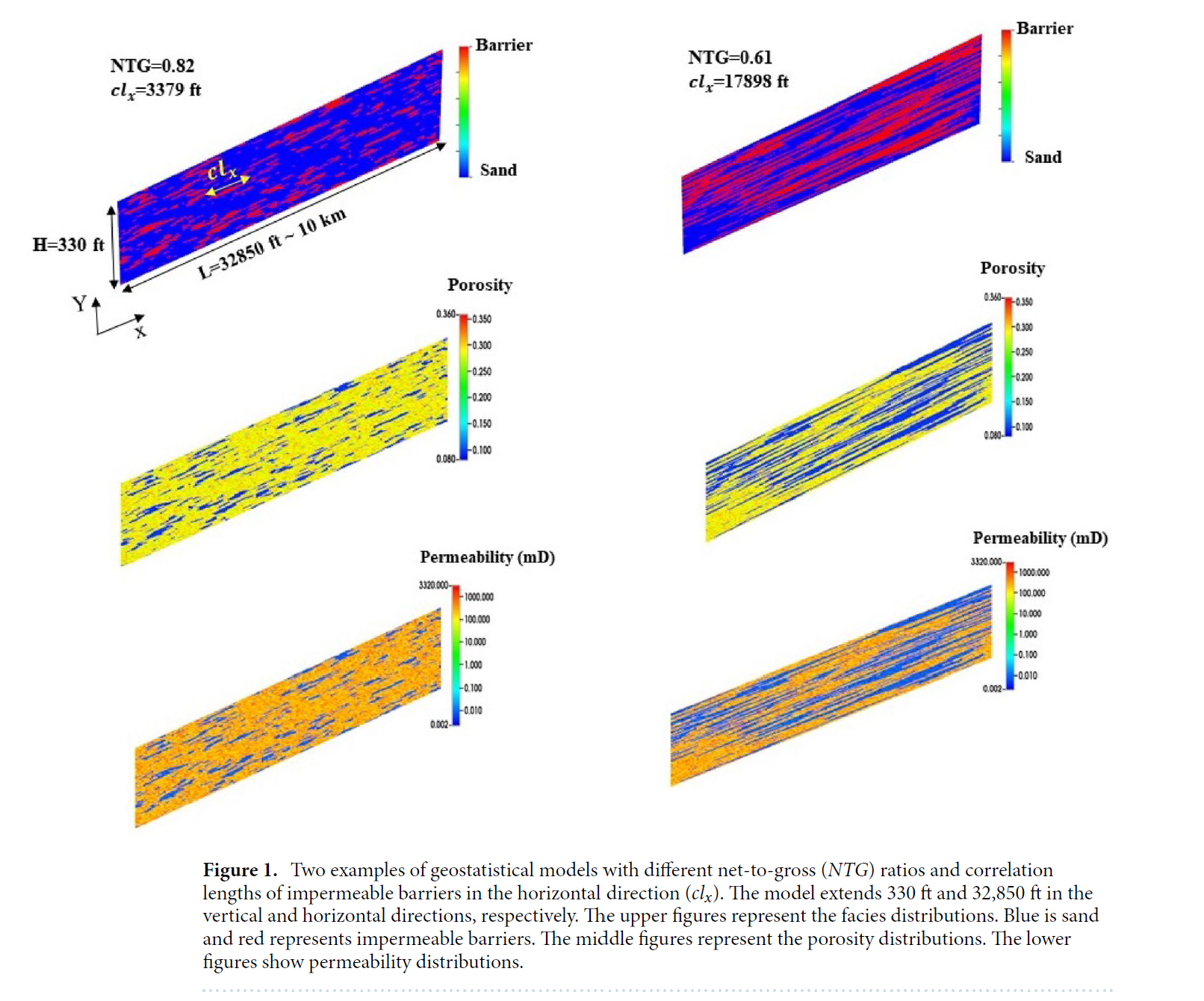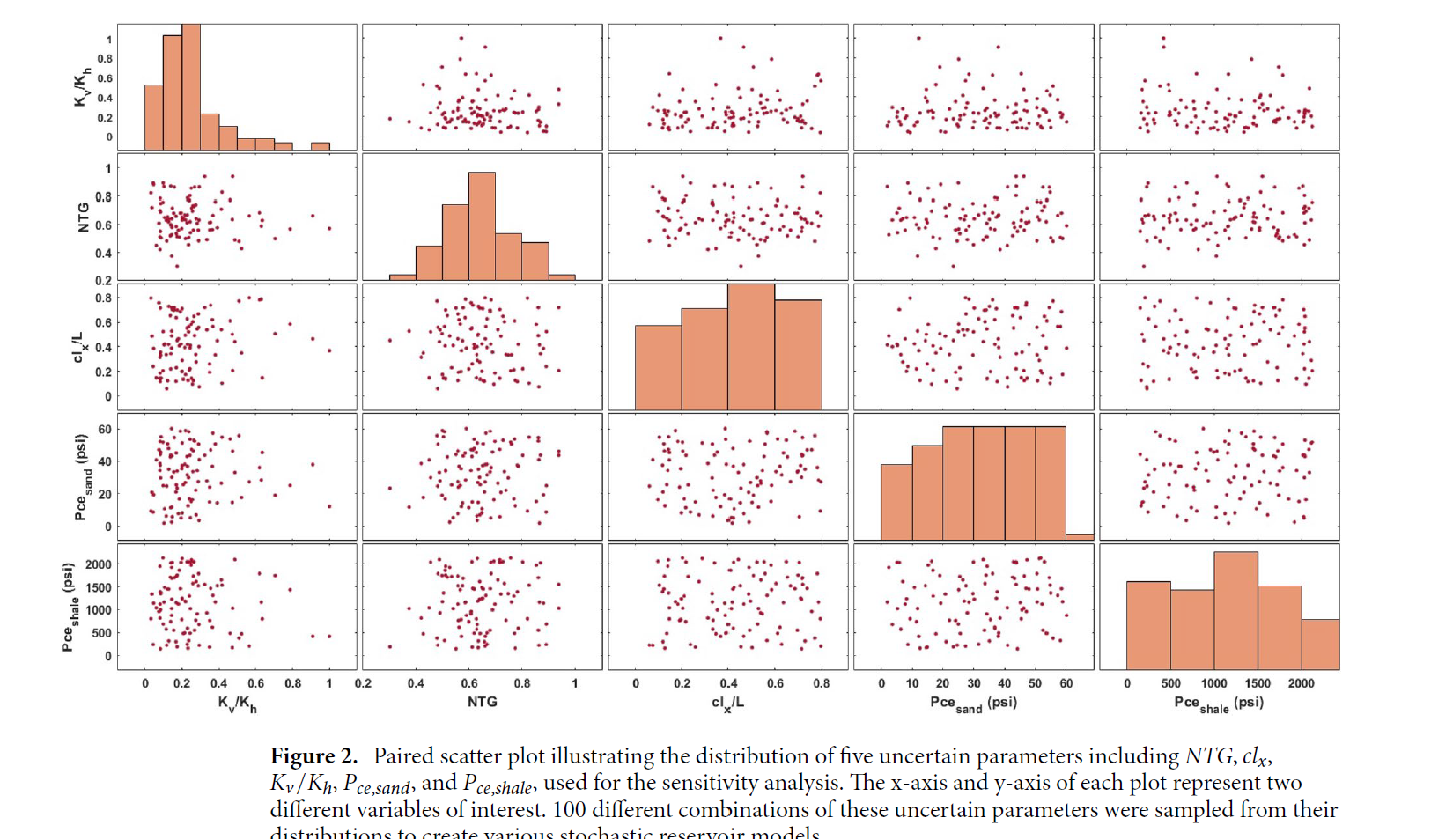Assessing the potential of composite confining systems for secure and long‑term CO2 retention in geosequestration
德克萨斯大学奥斯汀分校杰克逊地质学院
为了实现CO2安全封存,需要选择具有地质年代证明可以封存浮力流体积聚的覆盖层储层。然而,考虑到CO2注入期限的限制,我们提出了一种使用不连续页岩/粉砂/泥岩屏障的复合系统,以防止CO2的垂直运移。本研究研究了复合封存系统中沉积构造对CO2运移和封存的影响。我们通过随机生成具有不连续屏障的岩性非均质储层模型,并与来自路易斯安那州南部油气田的测井数据和观察数据相匹配。然后,进行了大量的CO2注入和注入后的储层模拟,评估了CO2浓度运移和复合系统对一系列地质和流体参数的压力响应的敏感性,包括屏障的横向连续性、可渗透性、毛管压力对比等。
研究结果表明,屏障的横向连续性和可渗透性是影响CO2浓度形状和储层内压力积聚的主要因素,而可渗透性的影响尤其显著。分层屏障的重要性显而易见,因为它们促进了CO2的局部毛管力捕集,通过促进CO2浓度的更分散形状,最终减缓了注入后浓度受浮力驱动向上运移的速度。
Traditionally, this objective has been achieved by targeting reservoirs with overlying seals-regionally extensive, low permeability units that have been proven capable of retaining buoyant fluid accumulations over geologic time. However, considering that the amount of CO2 is limited by a decadal injection period, vertical migration of CO2 can be effectively halted by a composite system of discontinuous shale/silt/mudstone barriers in bedded sedimentary rocks. Here, we studied the impact of depositional architectures in a composite confining system on CO2 migration and confinement at reservoir scale. We stochastically generated lithologically heterogeneous reservoir models containing discontinuous barriers consistent with statistical distributions of net-sand-to-gross-shale ratio (NTG) and horizontal correlation lengths derived from well log data and observations of producing hydrocarbon fields in Southern Louisiana. We then performed an extensive suite of reservoir simulations of CO2 injection and post-injection to evaluate the sensitivity of CO2 plume migration and pressure response of the composite system to a series of geologic and fluid parameters including the lateral continuity of barriers, NTG, permeability anisotropy within the sand body, and capillary pressure contrast between the sand and shale facies. The results indicate that lateral continuity of barriers and NTG are the dominant controls on CO2 plume geometry and pressure build-up in the reservoir, while the impact of NTG is particularly pronounced. The significance of intraformational barriers becomes apparent as they facilitate the local capillary trapping of CO2. Those barriers improve the pore space occupancy by promoting a more dispersed shape of the plume and ultimately retard the buoyancy-driven upward migration of the plume post injection.
Reservoir model
We used an Equation-of-State (EoS) reservoir simulator for compositional modeling, namely, GEM [Computer Modelling Group Ltd. (CMG), Calgary, Alberta, Canada] to simulate CO2 storage in saline aquifers. Twodimensional reservoir models with dimensions of 32,850 ft and 330 ft in the horizontal and vertical directions are generated using a stochastic method. The reservoir’s lateral dimension is taken to be sufficiently large for better monitoring of the CO2 plume lateral extension in a long-term simulation. The upper and lower boundaries of
the reservoir were considered closed, while open boundaries are imposed on the lateral sides of the model by extending the pore volume of the outer boundary grid blocks. The model has a dip of 1 ◦ and depth of 8000 ft. The initial pressure and temperature of the reservoir were assigned using a hydrostatic gradient of 0.465 psi/ft and a geothermal gradient of 0.0165 F/ft, with surface pressure and temperature set at 14.7 psi and 60 F, respectively 30.



Summary
This study investigates the containment of CO2 in regards to its vertical migration within lithologically heterogeneous reservoir rocks composed of stacked fine-grained barriers interbedded within sand units known as composite confining systems5.The reservoir-scale two-phase flow simulations presented here are representative of the pressure-driven and buoyancy-driven flow of CO2 occurring during injection and post-injection in saline
aquifers. Heterogeneous facies models were generated through geostatistically populating horizontal discontinuous shale barriers into sand bodies. Numerous geologic models were generated encompassing various combinations of uncertain parameters, including NTG, clx , Kv/Kh , Pce,sand , and Pce,shale . We studied the impact of heterogeneous composite systems on the pressure- and buoyancy-driven migration of CO2 , the effectiveness of confinement, and the formation’s pressure response.
According to the simulation results, we observed that the existence of barrier layers exerts a significant influence on the vertical migration of the plume and the pressure propagation in the composite system. The dispersed flow path of CO2 plume, controlled by the spatial heterogeneity of capillary barriers, is more pronounced after the cessation of injection when the plume migrates upward due to the effect of buoyancy forces. Based on the parametric sensitivity analysis, it has been demonstrated that the lateral continuity of discontinuous barriers (i.e., clx ) and their volume fraction (i.e., NTG) play significant roles in determining the shape of the CO2 plume and vertical pressure communication in the system. With increasing the fraction of barriers and their horizontal length, the vertical movement of CO2 plume becomes restricted while its lateral movement is encouraged.Furthermore, the plume shape and pressure response and overall retention capacity of a composite system were
found to be more susceptible to changes in NTG than clx . Hence, NTG should be prioritized as the key factor for geologic characterization of composite systems, given its significant influence on the dynamic response of such systems to CO2 injection.
With regard to the findings of this study, it is reasonable to suggest that formations containing capillary barriers are effective in containing the injected CO2 plume within the formation, as heterogeneity serves to limit the reliance of the formation seal as the only mechanism for containment. Even though the composite system considered in this study acts as the injection zone, the efficacy of such a system for CO2 containment at the post-injection stage, where plume buoyant migration is dominant, has been demonstrated. A study by Bump et al.5 has provided further demonstration of the effectiveness of composite systems as a confining zone. The 3D reservoir-scale flow simulation in their study has shown that the migration of CO2 plume could be predominantly horizontal with minimal intrusion into the confining zone with the extent of the capillary barriers occupying at least 6 % of the reservoir domain.
